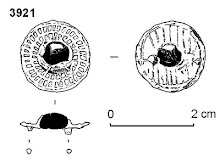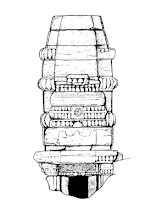Originally posted at The Day of Archaeology 2013
When I signed up to Day of Archaeology I thought I would be out
on site, I didn’t know where–originally it looked like a big site in London,
but that has been delayed, and then it seemed I’d be up the road on a site I
evaluated a couple of years ago. As the recent heat wave began I became a bit apprehensive
at the idea of digging 3m wide rubble-filled ditches in the baking heat, but
that site slipped
too…

So I am in my office finishing off the report for some
recent fieldwork I did in west Nepal for the Central Himalaya Project. The project
intended (amongst other aims) to record a sample of medieval stone monuments
belonging to the Malla dynasty, evaluate the suitability of recording
techniques including photogrammetry,
and try and develop a database for future assessment and analysis. In total we recorded
58 sites, with 32 temples, assorted other sites and monuments, and over 80
architectural fragments. The fieldwork was hard work –up by 6am, lug all the gear
to site, work through the day with a short break and back at 7pm for data entry
and downloading. But the team was good, the weather was hot, the beer was ice
cold and the scenery and locals were fantastic. It didn’t exactly feel like a ‘jolly’
as all my mates called it, but it was quite nice to be sipping single malt
looking at the stars and glad there wasn’t a CSCS card for thousands of miles.
 The downside of any expedition is coming home, and with
archaeology that doesn’t just mean returning to work, but writing up your
results. Fieldwork somehow always seems more ‘fun’ than the grind of
office-based Post-Ex, and there has been plenty of checking and cross-referencing
of records, data-entry, and form-filling to do. The monument gazetteer seemed
endless, the temple terminology impenetrable, and there were seemingly hundreds
of drawings to check, ‘ink up’ in Corel-Draw and work out exactly what each
stone fragment might represent.
The downside of any expedition is coming home, and with
archaeology that doesn’t just mean returning to work, but writing up your
results. Fieldwork somehow always seems more ‘fun’ than the grind of
office-based Post-Ex, and there has been plenty of checking and cross-referencing
of records, data-entry, and form-filling to do. The monument gazetteer seemed
endless, the temple terminology impenetrable, and there were seemingly hundreds
of drawings to check, ‘ink up’ in Corel-Draw and work out exactly what each
stone fragment might represent.


In amongst the grind there are moments when it all comes
together, managing to reconstruct a ‘lost’ temple from fragments of stone, the
satisfaction of finding that your thoughts on temple architecture were echoed
by published works, the realisation that common motifs and styles were being
used across hundreds of miles and on a wide variety of monuments of both Hindu
and Buddhist origin.














